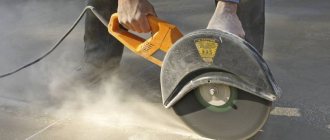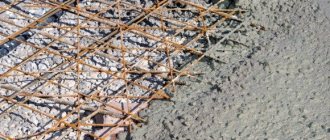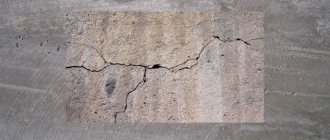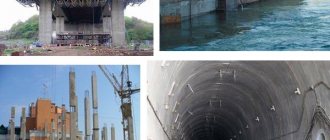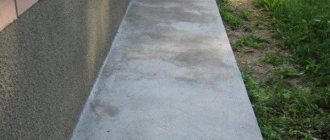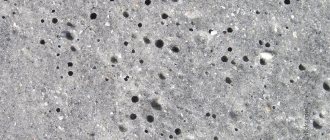Concrete is simply an irreplaceable material for construction, which is used everywhere. But in order to choose the right type of solution, it is necessary to take into account the main characteristics of the mass, such as workability, cone settlement and mass mobility. And exactly what the mobility of concrete is is what this article will discuss.
Construction mixture
Workability of concrete: dilution with water. Determination of elasticity by analyzing a monolith, cone
Concrete is simply an irreplaceable material for construction, which is used everywhere. But in order to choose the right type of solution, it is necessary to take into account the main characteristics of the mass, such as workability, cone settlement and mass mobility. And exactly what the mobility of concrete is is what this article will discuss.
Construction mixture
Basic terms and definitions
Before defining the main characteristics of the solution, it is necessary to clearly understand what this building material is.
Concrete is a composition consisting of four main components:
- Cement;
- Sand;
- Water;
- Crushed stone.
Note! If there is no crushed stone in the concrete, then it is just cement.
Concrete composition
The main task of concrete is to connect all components into a monolithic structure. Achieving this goal is only possible if the correct proportions of the two main components such as water and cement are observed.
Sand and crushed stone are referred to as fillers of the composition, and are used to impart strength to the mass and reduce possible deformations of the monolithic product after hardening. It is these fillers that make up the structural frame of a monolithic product, which makes it possible to increase the elasticity of the structure and reduce deformation under severe loads.
Mobility
The mobility or elasticity of a solution is an important property that can influence the choice of material for the construction of buildings and structures for various purposes. Mobility is the ability of a mass to fill the shape in which it is placed.
Note! The ability of a mass to fill a shape can manifest itself both under the influence of external forces and under the influence of its own mass.
According to GOST, the mobility of the concrete mixture is divided into 4 categories from p2 to p5, depending on the amount of added liquid. The less liquid, the thicker the solution, the thickest has the index p2, the most liquid, respectively, p5.
Based on plasticity indicators, building materials are divided into 2 groups:
- Sedentary or hard mixtures. They contain a small amount of water and are not able to fill the form in which they are placed under the weight of their own weight without the influence of external forces. Such compositions have indicators p2 or p3. Laying of the sedentary mass is carried out using vibrating and compacting equipment, which makes it possible to remove voids from the monolith;
Advice. If construction work using hard concrete is carried out in winter, the solution must first be heated.
- Mixtures with high mobility, liquid or castable. Solutions of this type have indicators equal to n4 or n5. Such masses are used in the process of pouring formwork, densely reinforced products and do-it-yourself columns.
Dilution with water
Liquid imported product
The low elasticity of the material can significantly increase the time for construction work if the necessary equipment is not available at the construction site. And in order to solve this problem, many resort to the dilution method, making p4-p5 mixtures from p2-p3 mixtures.
Note! Experts do not recommend resorting to the dilution method, because the ratio of liquid and cement in the raster is fundamental, violation of which will lead to loss of strength and quality of the structure.
If compaction is carried out correctly and the dilution method is eliminated, then you will get a strong, reliable structure, the mechanical processing of which can be carried out by such methods as cutting reinforced concrete with diamond wheels and diamond drilling holes in concrete.
Mobility indicators
In the case where the grade of concrete in terms of mobility has been chosen correctly, but it is ordered from a supplier and you have doubts about the compliance of the delivered product with the declared characteristics, and the price of the mixture is not so low, then you can check it at the construction site.
The mobility of a concrete mixture can be determined directly during unloading in 2 ways:
- Determination by monolith analysis;
- Cone for determining the mobility of a concrete mixture.
Determination of elasticity by monolith analysis
Monolithic cube
The instructions for such a test stipulate the possibility of determining any indicator of the plasticity of the mixture:
- Before starting the inspection, you should build several boxes in the shape of a cube with sides measuring 10-15 cm from wooden boards;
- Before pouring concrete into prepared forms, the wood should be slightly moistened to prevent moisture from being absorbed from the solution;
- We pour the solution into the boxes, after which the mass must be pierced with a sharp rod of reinforcement, thus compacting the monolith and releasing the air;
Advice. Additional compaction can be achieved by tapping the walls of the drawers with a hammer.
- The cubes must dry for 28-30 days at a temperature of at least 200C and a humidity of at least 90%;
- After the created samples have dried, they should be sent to the laboratory, where the mixture will be checked for compliance with the declared indicators.
The obvious disadvantage of this method is its duration, therefore the method of determining plasticity using a cone is more often used.
Determination of elasticity by cone
The photo shows a diagram of a cone
To use this method, you will need a cone to test the mobility of concrete with a height of about 30 cm. This form should not contain more than 6 liters of material.
This check is carried out as follows:
- The cone is filled with solution;
- Concrete is pierced to compact and remove voids;
- The cone is removed and placed next to the solution;
- We test for elasticity:
- If the concrete settlement is 5 cm, then you have hard concrete;
- If the settlement is more than 5 cm, then you have moving concrete.
Condition of the mass after removing the cone
Finally
Imported product
When working with concrete, it is necessary to choose the right grade of material in accordance with the elasticity of the mass and the purpose for which it will be used. Well, if you doubt that, for example, the mobility of P3 concrete is easy to check using the described methods.
The video in this article will tell you even more about how important it is to correctly select concrete in accordance with the elasticity parameters of the mass.
masterabetona.ru
To give up or not?
If your company is a small business, you do not need to take P-4. Individual entrepreneurs are also exempt from this obligation.
Other organizations, including separate divisions, must submit Form P-4.
Important! Instead of Form P-4, some organizations report using Form 1-T annually. This applies to garage and garage-building cooperatives, housing cooperatives, credit cooperatives, and social movements.
Fill out and submit Form P-4 for free right now! The external examiner will check for errors in your report. Use the service for 14 days for free!
Try for free
Download form P-4 for free
Mobility of concrete mixture
The mobility of a concrete mixture is the most important indicator affecting workability. It depends on several parameters, but the main one remains the percentage of water content in the mixture. Before starting any project, the necessary parameters must be assessed to ensure both maximum strength and the possibility of quick installation.
Types and marking of concrete by mobility
Building materials are also classified according to their mobility. In accordance with GOST 25192-82, special markings are made that allow you to evaluate the performance of the mixture before ordering.
- Zh1 – especially hard;
- Zh2 – increased rigidity;
- Zh3 – hard;
- Zh4 – moderately hard;
- Zh5 – sedentary;
- P1 – mobile;
- P2 – plastic;
- P3 – very plastic;
- P4 – cast;
- P5 – liquid.
Physical properties are usually tested in a laboratory before the material is shipped to the customer. If a person still has doubts, he can use one of the methods of determination in “field conditions”. After which you will be able to confidently begin to carry out the work, taking into account the requirements of the drafted project.
Application of concrete depending on mobility
Rigid concrete has practically no mobility, so this indicator is not calculated for them. Other types of building materials are widely used on sites, but depending on the physical properties, some restrictions appear.
Application of concrete P2 and P3
At the site, the low mobility of concrete P2 and P3 creates some difficulties. Such mixtures are characterized by a low percentage of water, so when using them it is necessary to use compaction or vibrating equipment. The material is not capable of occupying free volume under its own weight, therefore, without mechanical action, large and through pores are formed, violating the strength of the structure. Inexperienced builders often dilute the finished composition with water, but this should not be done. In this case, workability increases, but the compressive strength sharply decreases.
Application of P4 and P5 concrete
P4 and P5 concretes are easy to use, so they are excellent for pouring formwork, creating paths and platforms, as well as for filling densely reinforced foundations. The material is fluid and freely fills the volume, adhering tightly to the surface of the reinforcement. Craftsmen do not have to resort to construction equipment, which makes it possible to use such a mixture in everyday life without special skills.
Now St. Petersburg offers to order concrete in any quantity at the plant. Our own production allows you to buy a high-quality mixture with the required characteristics. In the assortment it is possible to find a material that is suitable for performing various works, and compliance with current GOSTs guarantees the implementation of a project of any complexity.
betoplus.ru
What does it depend on?
The mobility of the concrete mixture is determined by the grade of cement, the density of the cement paste, the water-cement content, the fraction and grain shape of the fillers (sand and crushed stone), the purity of the fillers (water, sand and crushed stone), the ratio of the components (sand, cement, water, lime, crushed stone) , quality and quantity of additives. It also depends on the conditions of pouring into formwork at the site.
A dense and voluminous reinforcement frame will require increased fluidity of concrete mixtures, since vibratory compaction is difficult in such conditions. When a low-moving composition is used in such conditions, the density after compaction may not meet the established standards (pores, cavities). Therefore, when selecting a concrete composition based on the degree of mobility (rigidity and cohesion), you should know the requirements for the supporting structure of the structure (especially important for the foundation) and the specific conditions for its pouring (the complexity of the formwork shape and the density of the reinforcement cage).
Concrete mobility value
Concrete is an indispensable material in construction, without which nowadays it is impossible to build either a country cottage or a modern skyscraper. The high consumer qualities of this material make it possible to use it in almost any area of construction - from house building to laying transport highways.
Flexibility is a workability characteristic that is capable of deforming under its own weight.
In order to choose the right solution for certain purposes, you need to know its main characteristics, which include workability, cone slump and concrete mobility. Taking these factors into account will allow construction work to be completed with the highest possible quality, which will guarantee a long service life and reliability of the constructed facility.
Definition of the term
Before talking about the characteristics and properties, it is necessary to find out what this building material is. The so-called ready-mixed concrete is a composition that has a certain mobility and consists of 4 main components: cement, sand, water and crushed stone. If crushed stone is not used in the mixture, it is called cement mortar.
The main task is to connect the required components into a single monolithic structure.
Determination of mobility using a cone: a – general view; b – hard mixture; c – sedentary; g – mobile; d – very mobile; e – cast.
This is only possible if the correct proportion of the two main components is observed - water and cement. Sand and crushed stone are added to the composition not for strength, but to reduce possible deformations of the cement stone after hardening. They create a structural frame that is able to absorb shrinkage stress, due to which the structures shrink less. In addition, elasticity increases and deformation under load decreases.
Mobility is an important factor influencing the choice of material for the construction of various types of objects. The workability of concrete is the ability to fill the form in which it is placed. Moreover, this property can be achieved both under the influence of external force and under the influence of its own weight.
Methods for determining consistency: a - by mobility using a standard cone: 1 - funnel; 2 - cone; 3 - pallet; 4 - measuring ruler; b - according to hardness - with a technical viscometer: I - device; II - concrete before vibration; III - after vibration; 1 - cylindrical ring; 2 - reference cone; 3 - funnel; 4 - tripod; 5 — disk with holes; 6 — rod; 7—vibrating platform.
Nowadays, the workability of concrete is divided into several categories (from p2 to p5) and depends on the amount of water that is added. The smaller the amount of water, the correspondingly thicker the mixture. The thickest concrete has an index of p2, and the thinnest concrete has an index of p4 or p5.
Frost resistance
The frost resistance parameter allows you to determine how many cycles of thawing and freezing a material can withstand over a certain time while maintaining its original characteristics. For marking, the symbol F and a numerical designation from 25 to 1000 are used. For example, consider what f75 concrete means. This value indicates that the building material is capable of maintaining its properties for up to 75 freeze/thaw cycles.
It is important to understand that sub-zero temperatures promote the expansion of moisture located in the pores of the building material - the larger the volume of these pores, the lower the frost resistance. At low rates, the material reduces the load-bearing capacity of building structures and ensures faster wear of their surface.
By finding out what concrete with one or another marking means, you can correlate its frost resistance with strength indicators. The table suggests the ratio of these parameters for the most common solutions.
| Class | Frost resistance | Brand |
| B12.5 | F50 | M150 |
| B15 | F100 | M200 |
| B20 | F150 | M250 |
| B22.5 | F200 | M200 |
| B25 | F200 | M350 |
| B30 | F200-F300 | M400 |
| B35 | F200-F300 | M450 |
Hardness (W)
The stiffness of a concrete mixture is characterized by the vibration time required to level and compact the preformed cone of the concrete mixture in a stiffness tester. Measured in seconds.
Hardness grades according to GOST 7473-2010):
| Brand | Hardness, s |
| Zh1 | 5-10 |
| Zh2 | 11-20 |
| Zh3 | 21-30 |
| Zh4 | 31-50 |
| Zh5 | More than 50 |
That is, the more time it takes to compact concrete, the harder it becomes: Zh 5 is the hardest, Zh1 is the least hard.
According to GOST 747Z-94
(which some manufacturers are still focusing on), it is permissible to use the following classification: according to workability, concrete was divided into: flexible (P), rigid (R) and super-rigid (SH).
Who is required to submit Form P-4 in 2021
Federal observation form P-4 “Information on the number and wages of employees” and instructions for filling it out were approved by Rosstat Order No. 412 dated July 24, 2020 (hereinafter referred to as Order No. 412). Help
In 2022, respondents will use form P-4, approved by Rosstat order No. 457 dated July 30, 2021.
This form is submitted by legal entities of all forms of ownership and types of economic activity. The only exceptions are small businesses - they do not have to fill out P-4.
Check the OKVED codes of “your” individual entrepreneur and his contractors
If an organization has separate divisions, information is compiled for each of them plus for the organization without taking into account the “separates.”
Attention!
Sometimes structural divisions of a company (for example, retail facilities or communication stores) can be reflected as one EP. This is acceptable if they are all located within the boundaries of one municipal district, urban district, or intracity territory of Moscow, St. Petersburg or Sevastopol. If a separate division operates outside of Russia, information about it is not included in Form P-4.
How to fill out the tabular part
Organizations that submit the form monthly fill in the columns with data for the reporting month. Legal entities submitting P-4 quarterly fill in the columns with data for the period from the beginning of the year (clause Instructions No. 457).
All indicators are distributed by type of activity according to OKVED in lines 02-11, and line 01 shows data for the organization as a whole. Line 01 should be equal to the sum of lines 02-11.
The payroll number is all employees indicated in the timesheet, with the exception of some categories (clause 77 of the Instructions for filling out form No. P-4).
Column 2 shows the average number of employees. It is equal to the sum of the payroll for each calendar day of the month, divided by the number of calendar days of the month. The average number of employees for a quarter is equal to the sum of the average number of employees for each month of the quarter, divided by three. It can be expressed in a form with one decimal place.
In column 3, indicate the average number of external part-time workers, and in column 4, executors under GPC agreements.
Columns 5 and 6 of the table include man-hours worked since the beginning of the year. This time includes all hours actually worked, even overtime, on weekends, holidays, and on business trips. There is no need to count sick leave, vacations, etc. (clause 82 of the Instructions for filling out form No. P-4).
The accrued wage fund is indicated in columns 7–10 (clause 83 of the Instructions for filling out form No. P-4).
In column 11, organizations need to reflect social payments (clause 88 of the Instructions for filling out form No. P-4).
Detailed instructions for filling out P-4, taking into account Rosstat instructions No. 457.


